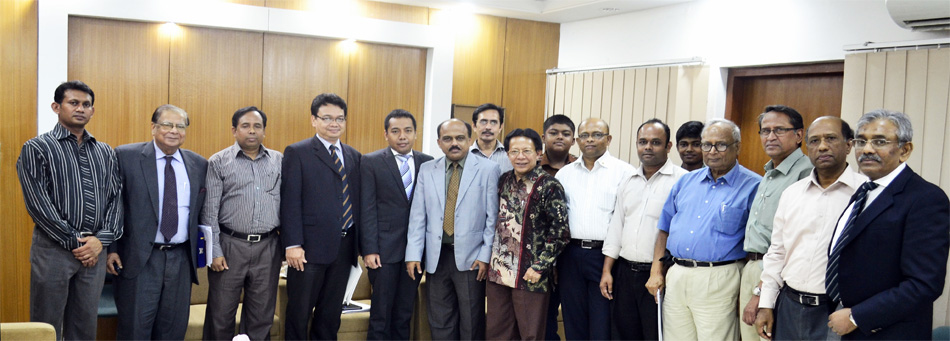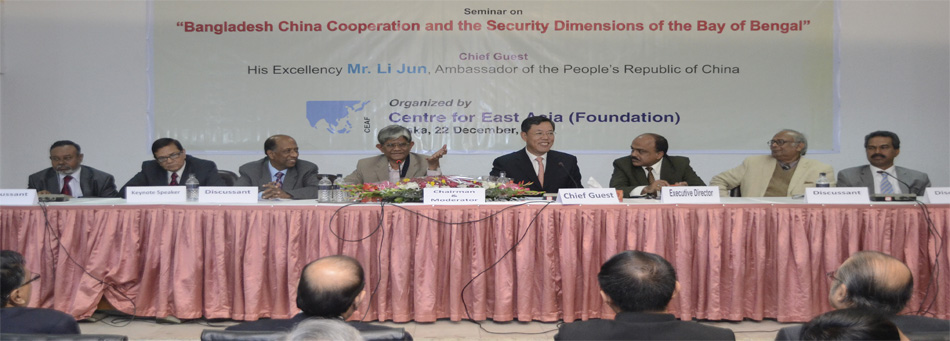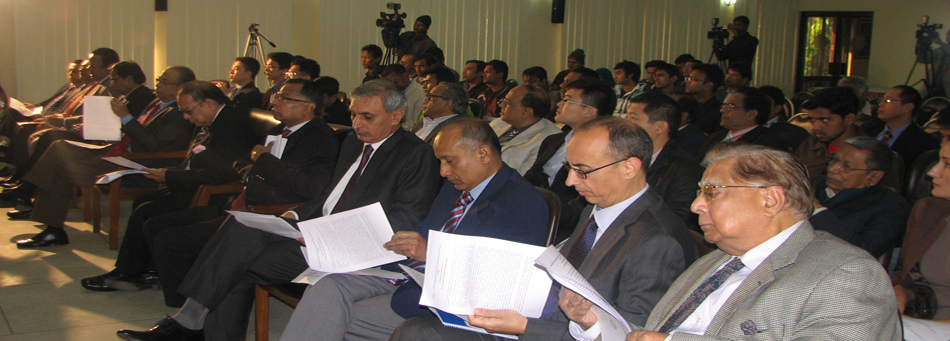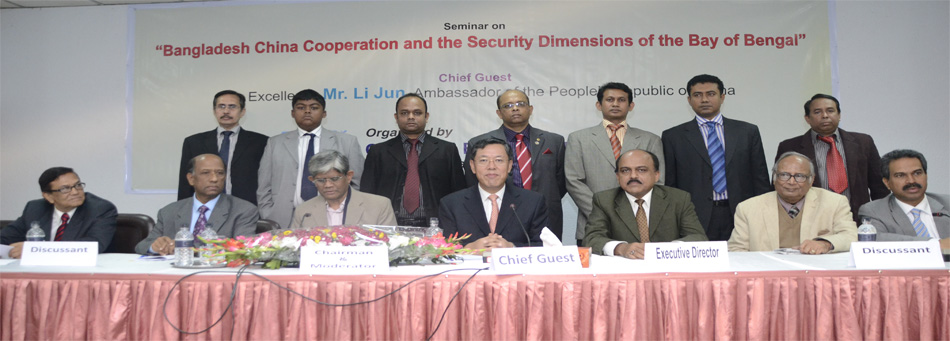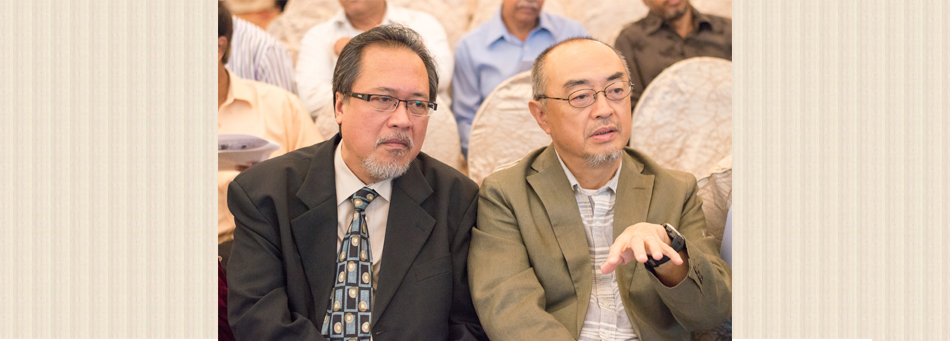Message:
BCIM Economic Corridor and its Significance to Bangladesh
By H.E. Mr. QU Guangzhou, Charge d’ Affaires, Chinese Embassy 2014-09-20, Dhaka
Hon’ble Advisor to the Prime Minister on International Affairs, Professor Gowher Rizivi,
H.E. Mr. Myo Myint Than, Ambassador of Myanmar to Bangladesh,
Brigadier General Thimmya, Defence Attache of High Commission of India,
Professor Sukomal Barua, Ladies and Gentlemen,Dear Friends,
Asala-mu-ali-gon and good morning!
At the outset, I would like to thank Centre for East Asia (Foundation) for organizing this seminar on BCIM Economic Corridor. This seminar is a good platform for officials and NGOs from BCIM countries to exchange views and present proposals for implementing the BCIM-EC initiative.
The concept of BCIM was raised by scholars from four countries in 1999. After nearly 15 years of Second Track discussion, China and India ultimately initiated to build the BCIM-EC during Chinese Premier Hon’ble Mr. Li Keqiang’s visit to India in May 2013. Since then, the initiative has received favorable support from the governments of the four countries, and the first inter-governmental joint working-group meeting was successfully held in Kunming last December. The BCIM countries are expected to present their national reports in the forthcoming second joint working-group meeting, which will be held In Bangladesh very soon.
Actually, I have talked a lot about the BCIM-EC in various occasions. China and India are two largest emerging economies, and Bangladesh and Myanmar boast rich human and natural resources. The future economic corridor could enable the four countries to take each other's advantages, accelerate economic growth, and open wider to the outside world. Given the outstanding significance of the BCIM-EC for the four countries, it deserves our all-out efforts to make it happen.
Ladies and gentlemen,
Today, I would like to share with you some ideas primarily on how to promote the BCIM Economic Corridor, which I believe is of the utmost importance.
In a short-term, the priority should be focused on mechanism building. Bangladesh will host the second joint group meeting of BCIM countries in late October. We hope this meeting could work on consensus of signing a BCIM Framework Agreement by the end of 2014 or early 2015, which will give formal institutional shape to BCIM Economic Corridor.
In a mid-term, early harvests should be achieved to bring visible benefits to four countries as soon as possible. The BCIM-EC is a long-term systematic project that cannot be completed overnight. It could only be done in a step-by-step manner. Priority areas and early-harvest projects may include infrastructural connectivity, trade and investment facilitation, industrial cooperation and cultural and people-to-people exchanges. As transportation and energy are posing considerable obstacles to closer regional cooperation, some mega projects on connectivity and power should be put on fast-tract.
In this regard, China stands ready to help. China has invited Asian countries to join Asian Infrastructure Investment Bank and most of them have indicated their readiness to join. Here, I have to share another good news with my audience, that just two days ago, the Chinese President Xi Jinping announced, during his historic visit to India, that China will provide $50 billion USD investment and $20 billion USD concessional loans to the South Asia countries in the next five years, which will bring new vigor and vitality into the development of BCIM-EC. During the visit of Honorable Prim Minister Sheikh Hasina to China, China and Bangladesh signed a MOU on Establishment of the Chinese Economic and Industrial Zone in Bangladesh. I hope that the Zone will take shape as soon as possible and attract huge Chinese investment, which will usher in a new era for bilateral cooperation and regional collaboration as well.
In long term, comprehensive and sustainable development should be the ultimate goal. All projects of BCIM-EC are designed to convert advantage of political relations, geographical proximity and economic complementary into dividend of practical cooperation and sustainable growth, aiming at smooth goods flow, sound governance, social harmony, mutual benefit and common development. In this context, BCIM countries should strengthen collaboration on their strategies, policies, plans and measures for cooperation and the BCIM-EC building. If we take a look at the world, we may find that the integration of Europe Union could be a mirror of future of BCIM-EC.
Ladies and gentlemen,
During the course of implementation of BCIM-EC, the role of the Think Tank is indispensible. Therefore, I sincerely appreciate Bangladeshi think tanks’ contribution to BCIM-EC and other related regional cooperation mechanism. Meanwhile, I have to keep it in mind that strong support from Bangladeshi Government is essential for the success of BCIM-EC.
Having said that, today’s seminar on BCIM-EC has special meanings. Bangladesh was one of destinations of the Southern Silk Road and the Maritime Silk Road. Let us pool our wisdom and resources, work together to write a new chapter in Asian regional cooperation and build a happy life for all of us. And I believe with strong support from Bangladesh, the establishment of BCIM-EC will be materialized in foreseeable future.
Thank you for your attention!
“BCIM-EC and Maritime Silk Route across the Bay”
(20 September 2014)
H.E U Myo Myint Than,
Ambassador of the Republic of the Union of Myanmar
Hon’ble Chief Guest, Professor Gowher Rizvi, Advisor to the PM on Int’l Affairs
Mr. Chair, Professor Sukomal Barua
Excellencies,
Dear Guests ,
Ladies and Gentalmen,
Minglaba, Assalamu’alaikum!
Very good morning!
It is my great honour and pleasure to participate in the seminar on BCIM-EC and Maritime Silk Route across the Bay. Today, I will be participating in this seminar in my personal capacity. I will be making my comments in two parts-BCIM-EC and the Maritime Silk Route. Myanmar has been involved in the BCIM initiative, since its inception.
The BCIM membership is composed of 4 neighboring countries, sharing similar culture and history.
In fact, the organization plays a pivotal role in realizing the objectives of poverty alleviation and the development of economic and social corridors.
The aim of the BCIM forum is for economic cooperation of which there are four sectors :(1) the development of a good infrastructure , (2) development of trade and investment cooperation, (3) progress in people to people contacts and (4) development in cooperation among regional authorities.
The BCIM Forum first commenced in 1999 and this annual event was last held in 2013 for the 11th time. Myanmar hosted the Fouth BCIM Forum in Yangon on (19-21) March 2003 and the Eigth BCIM Forum in Nay Pyi Taw on (23-24) July 2009. And the 12th BCIM forum will be held in Nay Pyi Taw .
After the concept of BCIM has been discussed at the Track II level meetings of the BCIM forum in the past few years, BCIM forum has made a lot of progress.
In this regard, we may recall that the first intergovernmental Joint Study Group meeting of the BCIM countries was held on 18-19 December 2013 in Kuming , Indeed, meeting symbolished the graduation of the BCIM initiative from Track II to Track I.
It is also foreseen that the economic advantages of the BCIM-EC will be quite considerable. For example, the proposed economic corridor would provide BCIM members with access to markets in South East Asia, trade and investment, infrastructure development and tourism etc.
I also wish to mention that BCIM car rally crossing 4 BCIM member countries in February 2013 popularized the idea of BCIM connectivity and promoted the idea of BCIM –EC.
Hon’ble Chief Guest,
Mr. Chair
Excellencies,
Dear Guests,
In this age of globalization, many countries in their respective regions are aiming for regional integration through economic integration.
In Asia, ASEAN is one of the most successful regional organizations. And in our part of the world, some sub-regional organizations such as Greater Mekong Sub region(GMS) has been formed and are functioning successfully. BCIM forum is another sub-regional organization in the making, comprising four neighboring countries.
Although the BCIM-EC was jointly proposed by India and China, it is hoped that BCIM-EC will bring economic opportunities and improve regional connectivity to all countries in this sub-region. We are also of the view that since it is strategically located in the sub-region. I note that high-level talks took place in May 2013 between India and China.
At the talks, the two sides agreed to consult the other parties (Bangladesh and Myanmar) with a view to establishing a joint Study Group on strengthening connectivity in the BCIM region for closer economic, trade and people-to-people linkages and to initiating the development of a BCIM Economic Corridor.
Bangladesh also discussed with China during Her Excellency Sheikh Hasina’s visit to China last June. Therefore, the idea of BCIM-EC is gaining momentum. For its part, Myanmar is generally appreciative of the current efforts of the Joint study group to explore the possibility of creating BCIM-EC.
According to my knowledge, the cooperation area of BCIM-EC stretches from Kunming, (Yunnan Province, China), to Kolkata, (India) Mandalay, (Myanmar) up to Dhaka and Chittagong, (Bangladesh).
The BCIM-EC is designed to promote multi-sectoral cooperation in road transport, trade services and investment, sustainable development of the environment and people to people contact in the BCIM region.
Hon’ble Chief Guest,
Mr. Chair,
Excellencies,
Dear Guests,
Let me also share with you the priority areas that BCIM-EC needs to focus on:
- Connectivity
- Energy
- Investment and finance
- Trade in goods and services and trade facilitation
- Social and human capacity development, poverty alleviation
- Sustainable development
- People to people contact
As location of Myanmar makes it a land bridge in the establishment of BCIM-EC, Myanmar is taking an interest in the emergence of BCIM-EC. Myanmar also expects to reap economic benefits in the flow of trade between our neighbors.
Now, allow me to touch upon the proposed new Maritime Silk Route. Myanmar has historical and cultural ties with countries in South and South East Asia. Moreover, as the largest country in mainland South East Asia with a long coastline, Myanmar is taking an interest in the proposed maritime Silk Route. After joining ASEAN in 1997.
Myanmar is working with ASEAN members in regional connectivity initiatives. Myanmar also joined BIMSTEC in 1997 and BCIM forum in1999.
We also consider that maritime Silk Route can play an important role in the development of the nation by bringing new economic opportunities for Myanmar and its people.
Furthermore, we are also following with interest China’s efforts to revive maritime silk route, which is intended to revive an ancient route running from China through Southeast Asia and the Indian Ocean to Europe. In my personal view, this 21st century maritime silk route will complement the proposed BCIM-Economic corridor.
Compared to the BCIM-EC, establishment of the maritime Silk route will need broad discussions and more studies including track-2 level discussions to develop the concept further. In fact, Myanmar has shown interest in the BCIM-EC concept by participating in the first joint study group meeting of BCIM-EC in Kunming-Yunan province in December 2013.
Myanmar has also been invited to the second joint study group meeting scheduled to be held in Cox’s Bazar, Bangladesh on12-13 November 2014 to discuss the national study plan on the concept among BCIM member countries.
I hope that exchange of views at this seminar will add impetus to the planned 2nd joint study group meeting of BCIM-EC.
Hon’ble Chief Guest,
Mr. Chair,
Excellencies,
Dear Guests,
Because of its location, Myanmar has emerged in the 21st century as an important link by land and sea in the region.
Myanmar already has a number of sea ports along the Bay of Bengal in operation. Hence, we can say that Myanmar is in a good position to take advantage of both BCIM-EC and the new proposed maritime Silk Route across the Bay.
To sum up, Myanmar is cooperating with other BCIM members to work on the concept of BCIM-EC. At the same time, we are also taking an interest in ongoing efforts to revive a new Maritime Silk Route across the Bay. I would like to conclude by saying that more new ideas and suggestions will come out from this interesting seminar on the topic for our future discussions.
Thank you.
Welcome Address on BCIM-Economic Corridor Seminar
Honorable Chair of the today’s seminar Professor (Dr.) Sukomal Barua, Honorable Chief Guest H.E. Professor (Dr.) Gowher Rizvi, Advisor to the Prime Minister on International Affairs, Honorable Guests of honor H.E. Mr. Myo Myint Than, Ambassador, Embassy of the People’s Republic of the Union of Myanmar and H.E. Mr. Qu Guangzhou, Charge de Affaires, Embassy of the People’s Republic of China.
Keynote Speakers, Distinguished Guests and members of the Media.
I am particularly delighted at the presence of H.E. Shiro Sadoshima, Ambassador of Japan, Her Excellency Ms. Iwanja Campos da Nobrega, Ambassador of Brazil and other distinguished diplomats.
Assalamu Alaikum and Good morning.
On behalf of the Centre for East Asia (Foundation), I welcome you all to this seminar on “BCIM-EC and Maritime Silk Route Across the Bay”.
Let me first give you some idea about the Centre for East Asia Foundation (CEAF). CEAF is a non-profit, non-political and independent study circle that is engaged in research and analysis of geopolitical developments as well as dynamics of socio-economic development in the Asia Pacific region, east of Bangladesh borders.
Bangladesh is located between two Asian giants of economic growth, China & India, and also next to a pro-active catalyst of expanding regional cooperation, the ASEAN. The geographical position of Bangladesh at the apex of the Bay of Bengal possibly offers it the potential to develop as a hub for sea trade between a triple fold of Asian growth: Western China, SAARC and ASEAN.
The BCIM-EC concept, on the other hand, provides Bangladesh scope of land route connections with landlocked eastern Himalayan State of Nepal and Bhutan, as well as the isolated parts of Northeast India, BCIM-EC is in effect a revival of a southern trade and travel route, historically known as the Southwest Silk Road in Chinese annals. Between the governments of India and China, the BCIM-EC has been agreed on to be a K to K (Kunming to Kolkata) connection, avoiding sensitive pockets of unrest in northeastern parts of India, and having scopes of a number of radial connections enroute in Myanmar and Bangladesh. A deep sea port off Chittagong could provide a vital link to the 215t Century Maritime Silk Road, conceived by China, to this land route of BCIM-EC. The governments of Bangladesh and Myanmar have endorsed this basic K to K route with radial connection to sub-routes for the BCIM-Economic corridor.
Originating in 1999 as the Kunming Initiative, the Bangladesh, China, India and Myanmar (BCIM) subregion is now set on building this economic corridor that would involve more than 2 billion people. In January 2013, the first ever BCIM Car Rally was held between Kolkata and Kunming via Dhaka, to highlight road connectivity in the four countries.
BCIM initiative have gained momentum since Chinese premier Li Keqiang’s visit to India and the conclusion of the first official meeting of the joint study group of the BCIM Economic Corridor on 19 December, 2013. In December 2013, the four nations finally drew up the long-discussed plan, emphasizing the need to quickly improve physical connectivity in the region. This marked the formal endorsement of the BCIM-Economic Corridor by the four nations, wherein it was agreed that the corridor will run Kunming to Kolkata, linking Mindalay in Myanmar as well as Dhaka & Chittagong in Bangladesh.
In Bangladesh, the BCIM-EC plan is being looked upon by informed members of the civil society not just as an instrument of connectivity and trade, but also as a vehicle of “cultural transmission” as in the past; not just an economic trade route, but a community with “common interests, fate and responsibilities”. The BCIM corridor is a Win-Win arrangement. The linkages of transport, energy, and telecommunication networks will enable the region to emerge as a thriving economic belt that will promote social development of communities along the corridor. To date, South Asia has not come close to enjoying the same economic success that East Asia has reaped. BCIM might well be the game changer that South Asia needs.
My heartfelt thanks to H.E. Professor Dr. Gowher Rizvi, Hon’ble Advisor to the Prime Minister on International Affairs for his kind participation in this seminar as Chief Guest. My heartiest congratulations to the H.E. Mr. Myo Myint Than, Ambassador, Embassy of the People’s Republic of the Union of Myanmar and H.E. Mr. Qu Guangzhou, Charge de Affaires, Embassy of the People’s Republic of China. Also thanks to the Prime Minister’s Office, Chinese embassy and Myanmar embassy officials in Dhaka for their prompt and helpful cooperation in connection with this seminar.
I thank keynote paper presenters for their scholarly contribution.
I thank the Advisors, Directors and well wishers of CEAF for their continuous support & cooperation.
Once again, I welcome you all to the seminar.
Nasim Mahmmud
Executive Director
CEAF
September 20, 2014
Lakeshore Hotel
Gulshan-2, Dhaka
Honorable Chairman of the today’s seminar Dr. Salehuddin Ahmed.
Honorable Chief Guest Excellency Mr. Li Jun, Ambassador of the People’s Republic of China to Bangladesh.
Keynote speaker & discussants of today’s seminar.
Diplomats, Distinguished guests, members of the media & students from the various universities.
Assalamu Alaycum,
Welcome to the second seminar of CEAF. Let me first introduce our organization,
The Centre for East Asia Foundation (CEAF) is a non-profit, non-political independent strategic study circle engaged in research and analysis of geopolitical developments & economic opportunities in the eastern flank of Asia beyond Bangladesh borders. Under the changing world order and the ongoing globalization process, our study inevitably crosses our area of focus and connects with other growth centres and strategic developments affecting our parts. The foundation is, however, committed to enhance understanding & strengthen ties of the people & the policy makers of Bangladesh with those to East and South-East Asian Countries in particular.
Since the establishment of formal diplomatic relations between Bangladesh & China on 4th October 1975, friendship and cooperation between the two countries have been growing steadily and have stood the test of time. In 37 years of bilateral exchanges and development initiatives with Bangladesh, set an unique example of China has peaceful co-existence and partnership between countries with different social systems and cultural background. The two peoples of China & Bangladesh are now all weather friends. Bangladesh always adheres to “One China” policy. And China always supports Bangladesh in infrastructure and military capacity-building for safeguarding national sovereignty & independence. In 2010 the two sides decided to establish & develop a “closer comprehensive partnership of cooperation” from strategic perspective.I am happy to note that our honorable adviser Mr. Enam Ahmed Chowdhury is present here today as the leader of Bangladesh delegation to Anctad-3 in Santiago,Chile,he got the cooperation of Chinese delegation in obtaining the first ever membership an UN organization.
Bangladesh also looks forward to relocation of many labor-intensive industries from China to Bangladesh. This is likely to happen on account of rising labor costs and economic restructuring in China. Trade volume between Bangladesh and China has also been growing.
Bangladesh’s marine boundaries with Myanmar has been settled by international arbitration accepted by both sides under UN Convention on the Law of the Sea. Marine boundaries with India also are due to be settled by a different process under the UNCLOS. China has agreed to assist Bangladesh in the Construction of undertaking the Sonadia deep sea port of Chittagong. The project is open to other countries like India and the United States of America to participate in financing and management. Thus Bangladesh is actively engaged in developing climate of friendship and cooperation in the Bay of Bengal. A number of littoral states of the Bay and neighborly sub-Himalayan states are already involved in an initiative called the Bay of Bengal Initiative for Multi-SSectoral Technical and Economic Cooperation, or BIMSTEC. It groups together Bangladesh, Bhutan, Burma, India, Nepal, Sri Lanka and Thailand. The seven-country forum aims to achieve its own free trade area by 2017.
Bangladeshis believe the Asia pacific region as a whole can, should and will be a region of peace, harmony, security & economic prosperity, so that all its people can lead happy, free & worthy lives. We seek partnerships with our neighbors & beyond to acquire knowledge, develop technology, improve communications & to ensure a sustainable economic growth for all.
My heartfelt thanks to H.E. Mr. Li Jun, Ambassador of China to Bangladesh for making time out of his busy schedule to attend this seminar as Chief Guest.
I thank the keynote speaker for his scholarly contribution & the designated discussants for their time & comments.
My felicitations go also to Directors, Advisors & well wishers of CEAF for their contribution & support.
In the end, on behalf of CEAF, I solicit suggestions from all quarters including the diplomatic missions in Dhaka about possible programs that we might undertake for to promote peace & amity between nations not only in Asia Eastward from our country, but also in “the shared earth” of the comity of nations.
Thank you all.
Nasim Mahmud
Executive Director
Centre for East Asia Foundation
Date: 22/12/2012.
Welcome Address
Honorable Chairman of the today’s seminar Ambassador Md. Humayun Kabir.
Honorable Chief Guest H.E. Mr. Dan W. Mozena, Ambassador of the United States of America to Bangladesh.
Keynote speaker and designated discussants of today’s seminar
Distinguished Guests & members of the media.
I am particularly delighted at the presence of H.E. Mr. Li Jun, Ambassador of China to Bangladesh, H.E. Mr. Myo Myint Than, Ambassador of Myanmar and Spanish Ambassador H.E. Mr. Luis Tajada Chacon with his wife and distinguished Diplomats.
Assalamu Alicum & Good morning
I, Welcome you all to this seminar of CEAF. Let me first introduce our organization The Centre for East Asia Foundation (CEAF) is a non-profit, non-political & independent strategic study circle engaged in research and analysis of geopolitical developments & economic opportunities in the eastern flank of Asia beyond Bangladesh borders. Bangladesh is located between two Asian giants, China & India. Its geographical position capping the Bay of Bengal gives Bangladesh a Unique incentive to connect two major regional forums, SAARC & ASEAN. I envision a Bangladesh that takes fullest advantage of its location at the nexus of the new Silk Road & the Indo-Pacific Economic Corridor. The foundation is, however, Committed to enhance understanding & strengthen ties of the people & the policy makers of Bangladesh with those to East & South-East Asian Countries in the Asia Pacific region.
After the liberation of Bangladesh in December 1971 the United States formally recognized the newly independent country is April 1972 and pledged US$ 300 million in Aid & become a leading trade & development partner. Today the relationship between the two countries is based on what is described by American diplomats as the “Three D’s” meaning Democracy, Development & Denial of space for terrorism. The strategic partnership agreement between Bangladesh & the US was signed in 2012, when former secretary of state Hillary Clinton visited Dhaka. I think, this partnership is deeply rooted in our shared democratic values, our strong economic ties, our mutual security concerns, and our broad and deep people-to-people connections.
Bangladesh’s marine boundaries with Myanmar has been settled by International arbitration accepted by both sides under UN convention on the law of the sea. Marine boundaries with India also are due to be settled by a different process under the UNCLOS. China has agreed to assist Bangladesh in the construction of the Sonadia deep sea port of Chittagong. The project is open to other countries like India and the United States to participate in financing and management. Thus Bangladesh is actively engaged in developing a benign climate of friend & cooperation in the Bay of Bengal. A member of littoral states of the Bay & neighborly sub-Himalayan state are already involved in an initiative called the Bay of Bengal Initiative for Multi-sector Technical & Economic Cooperation, or BIMSTEC. It groups together Bangladesh, Bhutan, Myanmar, India, Nepal, Srilanka & Thailand. The seven country forums aims to achieve its own free trade area by 2017.
Beyond the Bay of Bengal, Bangladeshis believe the Asia Pacific region as a whole can, should & will be a region of peace, harmony, security & economic prosperity, so that all its people can lead happy, free & worthy lives. We seek partnerships with our neighbors & beyond to acquire knowledge, develop technology, improve communication & to ensure a sustainable economic growth for all.
My heartfelt thanks to H.E. Mr. Dan W. Mozena, Honorable Ambassador of USA to Bangladesh for making time out of his busy schedule to attend this seminar as Chief Guest. Dan is very popular ambassador around Bangladesh. I also thank US Embassy in Dhaka for their excellent & proactive cooperation. I thank the keynote paper presenter for his scholarly contributions & the designated discussants for their time and comments.
I also thank to Directors, Advisors & well wishers of CEAF for their contribution & support.
In the end, on behalf of CEAF, I solicit suggestions & cooperation from all quarters including the diplomatic mission in Dhaka about possible programs that we might undertake for to promote peace & amity between nations not only in Asia Eastward from our country, but also in the shared Earth of the comity of nations.
Thank you all
Nasim Mahmmud
Executive Director
Remarks by H. E. Mr. Dan W. Mozena, the US Ambassador to Bangladesh in a Seminar jointly organized by the US Embassy, Dhaka and Center for East Asia Foundation (CEAF) on August 31, 2013 at BRAC Inn Auditorium, Mohakhali, Dhaka
The topic was
“U.S.-Bangladesh Relations with Special Reference to Security in the Bay of Bengal”
Ambassador Humayun Kabir, Chairman and moderator of this event
Nasim Mahmud, Executive Director, Center for East Asia Foundation
Professor Ataur Rahman, Keynote Speaker
Distinguished discussants too numerous to recognize individually
… and all who care about U.S.-Bangladesh Relations, especially as they relate to maritime security
Asalaam ‘mlaikum and good morning.
I can hardly wait …
… but wait I must … until November…
… come November I hope to be in Chittagong
… I hope to be standing dockside…
… my eyes will be searching the horizon for something big, real big … 378 feet of big … big in size and big in power projection …
… I speak of the Shomundro Joi, which will be the largest and arguably the most capable ship in the Bangladesh Navy. This ship, recently retired from active duty in the U.S. Coast Guard, was granted by the U.S. Government to Bangladesh, and Bangladesh undertook to modernize and upgrade the vessel.
Perhaps, you are wondering “why?” Why would the United States give this valuable ship to Bangladesh? Why would the U.S. invest in months and months of intensive training for the Bangladeshi officers and crew who will man the vessel? Why would the U.S. help Bangladesh to put in place a logistical support mechanism to ensure that the vessel remains in top form? Why would the American Ambassador to Bangladesh commit himself to do everything possible to ensure that Bangladesh is well positioned to receive a second vessel, a sister for the Shomundro Joi?
The answer to all these questions is the same: Bangladesh matters; Bangladesh matters importantly to America. Bangladesh, the world’s seventh largest country, is a moderate, secular, tolerant, democratic alternative to violent extremism in this troubled region of the world … Bangladesh matters to America. As Bangladesh improves relations with its neighbors, especially India and Myanmar, Bangladesh brings greater stability to the region … truly Bangladesh matters to America. Bangladesh, the largest contributor of policemen and policewomen and soldiers to international peacekeeping operations, contributes greatly to global peace … and that matters to America.
Bangladesh matters to America in so many other ways: helping the world’s growing population become food secure; expanding trade and investment, thus creating jobs in both countries; strengthening Bangladesh’s democratic institutions and respect for human rights; and preparing for natural disasters, such as cyclones and earthquakes.
To fully understand why Bangladesh matters to America, I want to shift lens for a few minutes and look at the broader context: the Asia Pacific region. America’s so-called “pivot” to the Asia Pacific simply recognizesthe reality that America is and long has been a Pacific nation, and our engagements with the Asia Pacific region course all the way to the subcontinent, which, of course, includesBangladesh. I believe that much of the history of the 21st century will be written in this broader Asia-Pacific region, projected to become home to over 5.2 billion people by 2050.
America’s engagement with the Asia Pacific region recognizes that America’s future prosperity and security will be influenced importantly by events and developments in the region. Home to two-thirds of the world’s population and the world’s fastest growing economies, the Asia-Pacific offers growing opportunities and challenges for U.S. strategic interests. Placing U.S. interests in context, the annual flow of U.S. investment into East Asia has increased from $22.5 billion in 2009 to $41.4 billion in 2011. U.S. exports to the Asia-Pacific totaled over $320 billion in 2012.
America’s relationship with the Asia-Pacific region now seeks to add an important new dimension. Yesterday the 19th round of negotiations to create a Trans-Pacific Partnership ended in Brunei. The Trans-Pacific Partnership -- the TPP – is a proposed free trade agreement that would foster Asia-Pacific economic integration by facilitating greater trade and investment among its members, an ever growing list that currently includes the U.S. and Australia, Brunei, Chile, Canada, Japan, Malaysia, Mexico, New Zealand, Peru, Singapore and Vietnam. Our vision is that other Asia Pacific countries would also join the TPP over time.I hope Bangladesh will seek to join the TPP, as entry into this free trade block would be a huge boost for Bangladesh’s exports. Of course, acceding to the TPP will not be easy as member-states need to address concerns regarding workers’ rights and protections, environmental protection, conservation, among other matters.
I believe greater access to the American and other TPP markets would help propel Bangladesh to become the world’s largest exporter of readymade garments and household textiles and a huge player in the global market for generic pharmaceuticals, shoes, finished leather goods, jute and silk products, among many other products. Explosive growth in these sectors would enable Bangladesh to take full advantage of the demographic dividend as millions of young Bangladeshis enter into their productive years. I hope the Government of Bangladesh, business interests of Bangladesh, and the civil society of Bangladesh will rigorously explore possibilities of Bangladesh’s joining the TPP. As I said, this would not be easy, but the benefits would be enormous in catapulting Bangladesh to the ranks of a middle-income country … not only in some statistical sense, but in the sense that all Bangladeshis would have the means to provide their families good, secure housing, ample, nutritious food, good healthcare, and quality education.
I would like to shift focus back to dockside Chittagong, where the magnificent Shomundro Joi in November will join other manifestations of America’s deep partnership with Bangladesh in the maritime security sector.
Bangladesh, like America, is a maritime country, a country whose economic well-being is highly dependent upon the seas as most Bangladeshi exports are shipped by sea to America, Europe and other points around the world, and most Bangladeshi imports arrive by sea.
Aside from trade, Bangladesh has other key interests in the maritime sector. Bangladesh seeks to protect itself from those who use the seas to export terrorism, to traffic drugs, arms, and people, to commit piracy and robbery in the Bay of Bengal, to steal Bangladesh’s rich fish stocks in the Bay, to threaten exploration and, potentially, production of gas in Bangladesh’s maritime domain.
America’s security interests are advanced as Bangladesh enhances its capacity to protect its maritime assets. Thus, America has helped Bangladesh to create and develop a special forces capacity in the maritime domain, akin to the U.S. Navy Seals, to respond to threats to Bangladesh maritime security. This special unit, called SWADS, is operational and gaining valuable experience as it grows and matures.
America has partnered with both the Bangladesh Navy and the Bangladesh Coast Guard to enable both services to better protect the nation’s maritime assets. We have provided Bangladesh the fastest boats on Bangladesh’s waters, the 25 foot Defender and the 38 food Defiant class boats. These boats can run down and overtake any miscreant on the waters. Bangladesh security forces have put these boats to good use, and now are capable to respond within minutes to security incidents in the Chittagong Port area. In fact, maritime theft rates have dropped 70% in and around Chittagong Port, which has led to a drop of insurance rates by about a third.
America has also partnered with Bangladesh to enhance the country’s resilience to cyclones, tidal surges and floods. Over the years, America has built or rebuilt over 550 cyclone shelters, and we now are engaged in building 130 more. Thirty of these cyclone shelters will be Coastal Crisis Management Centers strung along Bangladesh maritime districts. These thirty specialized shelters will be manned around the clock by Coast Guard units, who will use them to enhance Bangladesh’s ability to patrol its maritime and riverine assets. Some of the Centers will be outfitted with specialized capacity to identify ships in Bangladesh’s waters, thus enhancing maritime domain awareness. All of the thirty Centers will have cyclone-proof communications systems so that in the immediate aftermath of a cyclone they can report quickly to disaster management authorities the extent of damage in the vicinity. This will enable the government to identify the areas most impacted by the cyclone so rescue and relief efforts can be focused on the areas in most urgent need.
I am proud of the strong partnership between America and Bangladesh in helping Bangladesh secure it maritime borders. I look forward to further expanding this partnership.
I am proud of the strong partnership between America and Bangladesh in helping Bangladesh secure it maritime borders. I look forward to further expanding this partnership.
Focusing more broadly, I believe the U.S.-Bangladesh partnership is at an all time high. Aside from the tremendous progress in the maritime security sector, this partnership has yielded rich results in enabling Bangladesh to approach food self-sufficiency, to drastically cut maternal and child-under-five mortality, to enable Bangladeshis to have the family size they want, to mitigate for and adapt to the effects of climate change, to enhance its capacity to respond to natural disasters, including earthquakes, to better secure its land borders, to train and support international peacekeepers, to help the police introduce a new community-based philosophy of policing, and the list goes on and on.
Of course, as in any partnership, there are areas of disagreement, such as providing refuge for bona fideRohingyarefugees, sustaining the integrity and effectiveness of Grameen Bank, and providing space for human rights organizations. I believe that over time we can work through these differences.
Meanwhile, my concluding point is a simple one: the relationship between America and Bangladesh has never been better. This relationship, this partnership has never been deeper, broader and stronger than it is at this very moment. Then Secretary Clinton’s visit to Bangladesh last May solidified this relationship, and the Partnership Dialogue that she and Foreign Minister Dipu Moni agreed to establish has codified this partnership. I believe this powerful partnership will continue to work to the advantage of the people of Bangladesh, of America and of the region.
I commit myself, my Mission and my government to do everything that we can to take this relationship to even higher heights … to the benefit of the people of both nations and the region.
Thank you.


